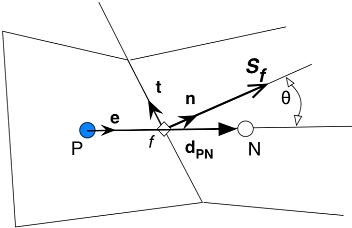Diffusion term
From CFD-Wiki
Contents |
Discretisation of the Diffusion Term
Description
For a general control volume (orthogonal, non-orthogonal), the discretization of the diffusion term can be written in the following form

where
- S denotes the surface area of the control volume
 denotes the area of a face for the control volume
denotes the area of a face for the control volume
As usual, the subscript f refers to a given face. The figure below describes the terminology used in the framework of a general non-orthogonal control volume

A general non-orthogonal control volume
Note: The approaches those are discussed here are applicable to non-orthoganal meshes as well as orthogonal meshes.
A control volume in mesh is made up of set of faces enclosing it. Where  represents the magnitude of area of the face. And n represents the normal unit vector of the face under consideration.
represents the magnitude of area of the face. And n represents the normal unit vector of the face under consideration.
If  and
and  are position vector of centroids of cells P and N respectively. Then, we define
are position vector of centroids of cells P and N respectively. Then, we define

We wish to approaximate the diffusive flux  at the face.
at the face.
Approach 1
A first approach is to use a simple expression for estimating the gradient of a scalar normal to the face.
where  is a suitable face average.
is a suitable face average.
This approach is not very good when the non-orthogonality of the faces increases. If this is the case, it is advisable to use one of the following approaches.
Approach 2
We define the vector

giving us the expression:
where  and
and  are suitable face averages.
are suitable face averages.
References
- Ferziger, J.H. and Peric, M. (2001), Computational Methods for Fluid Dynamics, ISBN 3540420746, 3rd Rev. Ed., Springer-Verlag, Berlin..
- Hrvoje, Jasak (1996), "Error Analysis and Estimation for the Finite Volume Method with Applications to Fluid Flows", PhD Thesis, Imperial College, University of London (download).
Return to Numerical Methods

![D_f = \Gamma _f \nabla \phi _f \cdot \vec S_f = \Gamma _f \left[ {\left( {\phi _N - \phi _P } \right)\left| {{{\vec S_f} \over {\overrightarrow{d_{PN}}}}} \right|} \right]](/W/images/math/2/2/f/22f7fe72fd16546ff2d65bf48adf7a35.png)
![D_f = \Gamma _f \nabla \phi _f \cdot{\rm{\vec S_f = }}\Gamma _{\rm{f}} \left[ {\left( {\phi _N - \phi _P } \right)\vec \alpha \cdot {\rm{\vec S_f + }}\bar \nabla \phi_f \cdot {\rm{\vec S_f - }}\left( {\bar \nabla \phi_f \cdot {\overrightarrow{d_{PN}}}} \right)\vec \alpha \cdot {\rm{\vec S_f}}} \right]](/W/images/math/7/c/f/7cf1e0cce420c5d8f260ea5c7f3340ff.png)